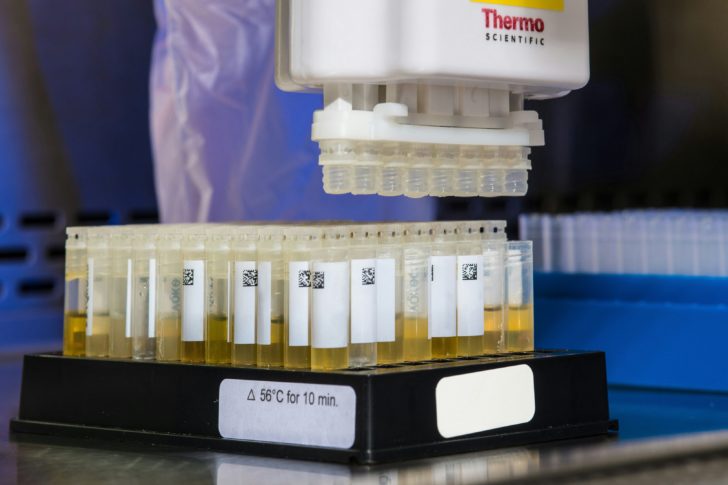Did you know that a simple urine test can reveal vital information about your health? Leukocyte esterase testing is one such method that can help detect inflammation or infection in your body, particularly in the urinary tract. In this comprehensive guide, we will delve into the intricacies of leukocyte esterase tests, their importance in diagnosing various health conditions, and how to maintain a healthy urinary system.
Table of Contents
Key Takeaways
The leukocyte esterase test is used to detect potential bacterial infections or inflammation in the urinary tract.
Abnormal results can have various causes and implications, requiring Evaluation by a healthcare professional.
Maintaining good personal hygiene, hydration levels and diet may help reduce the risk of UTIs.
Understanding Leukocyte Esterase: What Is It and Why Is It Tested?

Leukocyte esterase, an enzyme stemming from white blood cells, is a key component in the immune system’s battle against bacterial infections. The leukocyte esterase test is designed to detect inflammation or infection, typically in the urinary tract, which includes lower urinary tract infections. A laboratory technician usually performs the test using a urine sample, and the results can indicate the presence of white blood cells in the urine, suggesting a potential urinary tract infection or contamination from vaginal secretions.
Various levels of leukocytes in urine are indicated by distinct colors on the reagent pad, ranging from beige (light brown) for trace levels to dark/bright shades of purple for high levels. The maximum quantifiable level of leukocytes on a urine test strip is 500 cells/L. A positive result may indicate the presence of an infection or inflammation in the bladder or other parts of the urinary tract, and further evaluation may be necessary to determine the exact cause and proper treatment.
The Role of Leukocyte Esterase
White blood cells produce leukocyte esterase, a pivotal enzyme in the body’s immune response that combats bladder infections. The detection of leukocyte esterase in a urine test can suggest the possibility of a urinary tract infection or inflammation. This is because the enzyme is an indicator of the presence of white blood cells in the urine, which can be released by activated neutrophils that are recruited to sites of infection or inflammation.
The leukocyte esterase test, a form of urine examination, gauges the presence of leukocyte esterase in urine. It is a quick and convenient method for detecting infections or inflammations in the urinary tract, making it a valuable tool for early diagnosis and treatment of these conditions.
Learn more, please visit Leukocyte Esterase – an overview.
Common Reasons for Testing
The screening test for leukocyte esterase proves useful in detecting inflammation or infection, especially in the urinary tract. Typical symptoms that may suggest the need for a leukocyte esterase test include:
frequent urination
burning sensation when urinating
cloudy or pink-tinted urine
a strong odor in the urine
High levels of leukocytes in the urine can be indicative of a urinary tract infection.
A leukocyte esterase test is recommended in suspected kidney infection cases to detect significant pyuria associated with urinary tract infection (UTI). It has been observed to have a sensitivity of 75-96% and a specificity of 94-98% for UTI, making it an effective tool for screening.
Leukocyte Esterase Test Procedure: How It Works
The leukocyte esterase test is conducted using a urine sample and a dipstick test, which evaluates the enzyme’s presence in the urine. A midstream clean collection is the most suitable urine sample for the leukocyte esterase test. The procedure for performing the dipstick test involves inserting a dipstick, a thin plastic stick with chemical strips, into a urine sample. The chemical strips on the dipstick will change color if leukocyte esterase is present in the urine, thereby indicating the presence of white blood cells which may suggest an infection.
Before interpreting results, one must ensure the dipstick hasn’t expired and is held horizontally. The results of the leukocyte esterase test are typically available within minutes, making it a quick and convenient diagnostic tool for healthcare providers. With lab tests online, patients can also access information about this test and better understand their results.
Collecting a Urine Sample
To keep contamination to a minimum, one collects a clean-catch midstream urine sample. When performing a clean-catch midstream urine collection, it is essential to avoid common mistakes, such as:
Touching the inside of the urine specimen cup
Not cleaning the genital area properly before collecting the urine sample
Allowing the urine sample to come into contact with toilet paper or other materials that may introduce contaminants.
A clean-catch urine sample is the preferred method for the leukocyte esterase test. A special clean-catch kit, which includes a cleansing solution and sterile wipes, may be provided by the healthcare provider to collect the sample. Collecting a midstream sample is necessary for accurate results, as it helps to ensure that the sample is free of contaminants that may be present at the beginning or end of the urine stream.
Performing the Dipstick Test
In a dipstick test for leukocyte esterase, the process involves:
Dipping a reagent strip into the urine sample
Observing a color change on the strip
The color change corresponds to the level of leukocyte esterase present
The color-sensitive pad on the dipstick changes color based on the presence and concentration of leukocyte esterase
A deeper or darker color denotes a higher level of leukocyte esterase.
The initial step in administering the dipstick test for leukocyte esterase is to acquire a urine sample in a sanitary container. The test results are typically available within minutes, making it a quick and convenient method for detecting the presence of white blood cells in the urine, which may suggest inflammation or infection in the urinary tract.
Interpreting Leukocyte Esterase Test Results

Test results can help determine if there is an infection or inflammation in the urinary tract, with different color changes indicating varying levels of leukocyte esterase. A positive result is indicated by a color change to brown or any shade of purple, with the deeper or darker the color indicating higher levels of leukocyte esterase. A normal range for leukocyte esterase in urine is usually 0-5 white blood cells per high power field (WBC/HPF).
Abnormal results may suggest a urinary tract infection, kidney infection, or other inflammatory conditions. In such cases, further evaluation is needed to determine the exact cause and appropriate treatment. It is important to note that a positive leukocyte esterase test result alone is not a definitive diagnosis of infection or inflammation, and additional tests may be necessary to confirm the presence of an infection or inflammation in the urinary tract.
Normal Range of Leukocyte Esterase
In urine, the normal range for leukocyte esterase is under 5 cells/HPF, reflected by a light color on the reagent pad, indicating a negative result. A negative result on the leukocyte esterase dipstick test suggests a normal leukocyte range. It is important to be aware that factors such as:
urinary tract infections (UTIs)
kidney stones
tumors
autoimmune conditions
certain sexually transmitted infections (STIs)
can impact the normal range of leukocyte esterase in urine.
The exact impact of age and gender on the normal range of leukocyte esterase may vary and further research may be required to determine the precise ranges for different age groups and genders. However, it is known that the median age of male patients with leukocyte esterase positivity is lower than that of female patients, and the false positive rate for leukocyte esterase differs between men and women.
Abnormal Results: Causes and Implications
Abnormal leukocyte esterase test results are generally associated with urinary tract infections, genitourinary inflammation, kidney issues, and inflammatory medical problems. Elevated levels of leukocyte esterase in urine may be caused by urinary tract infection, kidney stones, and inflammatory medical conditions. A high level of leukocyte esterase can be indicative of a severe urinary tract infection.
If the leukocyte esterase test is positive, a urine culture is conducted to determine the type of bacteria causing the bacterial infection. This enables the selection of the most appropriate antibiotics for the treatment of the infection. Upon observing abnormal results, consulting a healthcare professional for the most effective course of action is crucial.
Leukocyte Esterase Test Limitations and False Positives
The leukocyte esterase test has limitations, including false positives and factors that can affect its accuracy. False positives in a leukocyte esterase test have been reported to occur in approximately 4% of cases, according to some studies. It is possible for a false positive result to be caused by:
Hemoglobinuria
Myoglobinuria
Menstrual blood
Concentrated urine
Strenuous exercise
Contamination of the urine sample with bacteria present in vaginal fluid
Non-infectious renal diseases such as glomerulonephritis
Certain medications like imipenem, meropenem, and clavulanic acid.
Additionally, medications can influence the accuracy of a leukocyte esterase test. Concentrations of certain medications, including tetracycline, can lead to false-negative test results. Furthermore, positive dipstick tests for leukocyte esterase can be caused by commonly used antibiotics. Hence, considering medication use is crucial when evaluating the outcomes of a leukocyte esterase test.
Factors Affecting Test Accuracy
Certain medications and medical conditions may influence the results of a leukocyte esterase test. These include:
Medications: gentamicin, nitrofurantoin, and tetracycline antibiotics
Vitamin C supplements
Medical conditions: elevated specific gravity, elevated protein levels, and urinary tract infections
It is important to note that the leukocyte esterase test may have a strong negative predictive value but a weak positive predictive value for detecting infection.
For accurate results in a leukocyte esterase test, follow these guidelines:
Follow the provided instructions.
Avoid contaminating test strips.
Stay aware of potential false-positives.
Keep hydrated.
Maintain good hygiene.
It is important to be aware of these factors and to discuss any concerns with a healthcare professional to ensure accurate test results.
Confirmatory Tests and Further Evaluation
Confirmatory tests, such as urine culture or imaging studies, may be needed for a definitive diagnosis. A urine culture is used to confirm the results of a leukocyte esterase test by identifying the specific type of bacteria present in the urine. The leukocyte esterase test detects the presence of white blood cells, which indicates inflammation or infection in the urinary tract. When the leukocyte esterase test returns positive, a urine culture is carried out to identify the infecting bacteria type, which aids in choosing the most suitable antibiotics for treatment.
Confirmatory urine tests should be conducted after a positive leukocyte esterase test to confirm the presence of urinary tract infection (UTI). The frequency of these tests may be determined by the clinical situation and the healthcare provider’s discretion. Therefore, it is advised to seek guidance from a healthcare professional on the appropriate timing of confirmatory tests.
Leukocyte Esterase in Special Populations
Leukocyte esterase testing is of particular importance for pregnant women and individuals with autoimmune diseases. The presence of leukocyte esterase in pregnant women’s urine can be indicative of a urinary tract infection or inflammation. Monitoring leukocyte esterase levels is critical as it aids in diagnosing and treating urinary tract infections throughout pregnancy.
In individuals with autoimmune diseases, elevated leukocyte levels in the urine may suggest inflammation or infection related to the autoimmune condition. Further medical assessment is required to identify the exact cause.
Pregnancy and Leukocyte Esterase
In pregnancy, testing for leukocyte esterase can help detect urinary tract infections and preeclampsia, which require prompt medical attention. If left untreated, high leukocyte levels in the urine during pregnancy can result in kidney infections or sepsis, thus necessitating the monitoring of leukocyte esterase levels and seeking appropriate medical treatment if required. Leukocyte esterase testing is utilized in detecting urinary tract infections during pregnancy by detecting the presence of white blood cells (leukocytes) in the urine. The test is conducted using a urine dipstick, and if leukocyte esterase is present, it suggests the presence of inflammation in the urinary tract, which can be an indication of infection.
Elevated levels of leukocyte esterase during pregnancy may be due to:
Urinary tract infections (UTIs)
Cystitis
Pyelonephritis
Genital infections
These conditions may lead to an increase in leukocytes in the urine. It is important to diagnose and treat any underlying infection or inflammation in pregnant women in a timely manner to ensure the health and well-being of both the mother and the baby.
Autoimmune Diseases and Leukocyte Esterase
In autoimmune diseases, the leukocyte esterase test can help identify infections that may exacerbate symptoms or complicate treatment. The leukocyte esterase test can be advantageous in the evaluation of lupus and Sjogren’s syndrome. It can be used to monitor kidney involvement and detect urinary tract infections in lupus patients, as well as to aid in the evaluation process of Sjogren’s syndrome.
Monitoring leukocyte esterase levels in individuals with autoimmune diseases can offer valuable insight for managing and monitoring autoimmune conditions. It is important for individuals with autoimmune diseases to work closely with their healthcare providers to ensure proper management of their condition and to minimize the risk of complications related to infections and inflammation.
Preventing Urinary Tract Infections and Maintaining a Healthy Urinary System
Maintaining a healthy urinary system and preventing urinary tract infections involves proper hydration, diet, and personal hygiene habits. Adequate hydration facilitates the elimination of bacteria and other toxins from the urinary system, while a balanced diet supplies the body with the essential nutrients to keep the urinary system performing optimally. Personal hygiene practices such as wiping from front to back and avoiding tight-fitting clothing can also help reduce the risk of urinary tract infections.
In addition to lifestyle changes, it is important to consult with a healthcare professional if you experience symptoms of a urinary tract infection or bladder infection. Early diagnosis and treatment can help prevent complications and ensure the proper functioning of the urinary system.
Hydration and Diet
Drinking plenty of water and consuming a balanced diet can help support urinary health and prevent infections. It is suggested to consume approximately 2.5 to 3.5 liters of water daily to sustain a healthy urinary system. In addition to hydration, it is recommended to avoid foods that can irritate the bladder and urinary tract, such as spicy foods, citrus fruits and juices, caffeine, alcohol, and carbonated drinks.
Certain nutrients and supplements that may be beneficial for urinary health include:
Vitamin C
Cranberry
D-mannose
Uva ursi
Garlic
Green tea
However, it is highly recommended to consult with a healthcare professional before beginning any new supplement regimen.
Personal Hygiene and Habits
Upholding good personal hygiene and cultivating healthy habits can help mitigate the risk of urinary tract infections. Here are some tips:
Urinate after sexual activity
Wipe from front to back after using the toilet to minimize the risk of introducing bacteria into the urinary tract
Avoid tight-fitting clothing
Wear breathable fabrics to maintain a healthy environment for the urinary system
Adhering to these straightforward tips and voicing any concerns with a healthcare professional can aid individuals in maintaining a healthy urinary system, thereby reducing the risk of infections and complications.
Summary
In conclusion, the leukocyte esterase test is a valuable tool for detecting inflammation or infection in the urinary tract. Understanding the test procedure, interpreting results, and being aware of limitations can help individuals and healthcare providers make informed decisions about diagnosis and treatment. Maintaining a healthy urinary system through proper hydration, diet, and personal hygiene habits is essential for preventing urinary tract infections and ensuring overall well-being. By staying proactive and working closely with healthcare professionals, individuals can safeguard their urinary health and enjoy a higher quality of life.
Frequently Asked Questions
What does it mean when you have leukocyte esterase in your urine?
Having leukocyte esterase in your urine is a sign that white blood cells are present, which suggests a urinary tract infection. A positive test result requires further evaluation under a microscope to confirm the presence of infection-fighting cells. If so, medical treatment may be necessary.
Should I worry about leukocytes in urine?
If your doctor finds an increased number of leukocytes in your urine, it could indicate a urinary tract infection, kidney stones, a pelvic tumor, or another condition. It’s important to get the underlying cause diagnosed and treated.
What infections cause leukocytes in urine?
Leukocytes in urine can be a sign of a urinary tract infection (UTI) or a kidney infection, kidney stones, an obstruction in the urinary tract or bladder, or a tumor in the pelvic area.
What is the normal range for leukocyte esterase in urine?
The normal range for leukocyte esterase in urine is a negative result (below 15 cells/L) which corresponds to less than 5 cells/HPF.
What are leukocytes?
White blood cells, also known as leukocytes, are an important part of the immune system that protect us against illness and disease. They are always on the lookout for foreign invaders such as viruses, bacteria, and other pathogens that can threaten our health, producing antibodies to fight them off.









